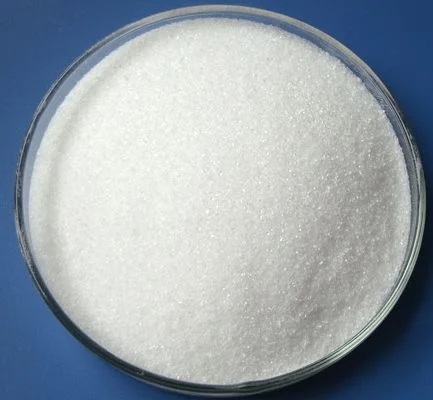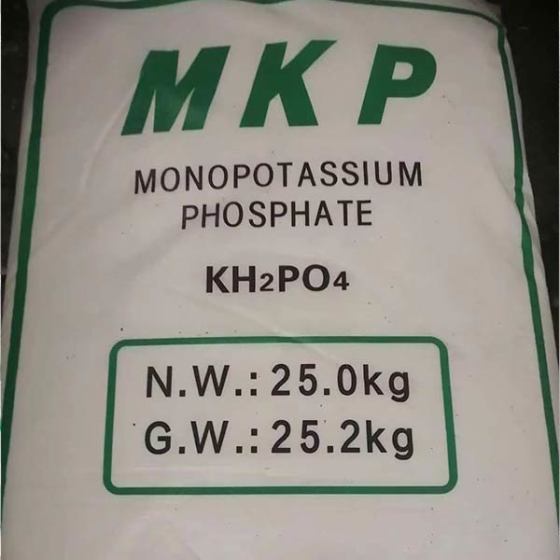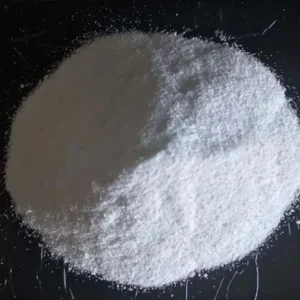MKP (Mono Potassium Phosphate)
Mono Potassium Phosphate (MKP) is a water-soluble fertilizer that supplies plants with a highly effective combination of phosphorus and potassium. Essential for energy transfer and photosynthesis, MKP enhances root growth, flower and fruit quality, and resistance to diseases. Perfect for foliar feeding and fertigation, MKP is free of chlorine, sodium, and heavy metals, making it safe for use on sensitive crops.
1.Nature:
Colorless to white crystalline or crystalline powder, odorless. The relative density is 2.338. Soluble in water, insoluble in ethanol. Aqueous solutions are acidic, and 2.7% of aqueous solutions have a PH of 4.2-4.7. Stable in air. Adi0-70 mg/kg(FAO/WHO, 1994).
Potassium dihydrogen phosphate (chemical formula KH2PO4) is a highly concentrated phosphorus and potassium complex fertilizer with a P2O5 content of 52% and K20 content of 34%. Small hygroscopicity, good physical properties, easy to dissolve in water, at 20℃ per 100 ml of water can be dissolved 23g, the aqueous solution is acidic.
2.Introduce:
Potassium dihydrogen phosphate is an efficient and fast soluble phosphorus potassium complex fertilizer containing phosphorus and potassium, which is used to provide nutrients needed for plant growth and development. It is suitable for any soil and crops, especially for areas where phosphorus and potassium nutrients are lacking at the same time and phosphophilic crops. Chemicalbook is mostly used for topdressing, seed soaking and seed dressing, with remarkable yield increase effect. If it is used as root fertilization, it can be used as base fertilizer, seed fertilizer or middle and late topdressing. The aqueous solution can react with silver nitrate to produce yellow silver dihydrogen phosphate precipitation, which can be used as a differential reaction.
Because potassium dihydrogen phosphate is more expensive and agricultural products are produced less, it is often used by soaking seeds or topdressing outside the roots. The concentration of field crops is commonly 0.2%, soaked for 18 to 20h, and can be sown after drying. For external topdressing, if sprayed alone, the maximum concentration can be 0.5%. For example, in the jointing booting period of wheat and rice, the first flowering period of cotton and rape can be sprayed 1 to 2 times. When spraying 2 times, the interval is about 7 to 10 days, and the amount of liquid used per mu is about 100 to 150kg of chemical book. It can also be combined with other nutrients to form compound nutrient solution for external topdressing. For example, a variety of leaf fertilizers used in field crops in North China are mainly composed of potassium dihydrogen phosphate, urea and some trace elements. In recent years, potassium dihydrogen phosphate (KDP) has been used as a kind of phosphate and potassium fertilizer source with high concentration and good hydrophilicity. With the development of facility horticultural crops, drip irrigation and fertilizer irrigation, the demand for potassium dihydrogen phosphate products is increasing.
3.Effect:
1.Promote nitrogen and phosphorus absorption. Potassium dihydrogen phosphate can promote the absorption of nitrogen and phosphorus by crops, quickly supplement phosphorus, improve crop yield and 1000-grain weight, and play a special role in the special physiological period of crops.
2.Promote photosynthesis. Potassium in crop growth plays a role in enhancing crop photosynthesis, accelerating the production and conversion of nutrients.
3.Improve crop resistance. Potassium dihydrogen phosphate can improve the resistance of crops, such as drought resistance, dry hot air resistance, Chemicalbook waterlogging resistance, freezing resistance, damage and healing resistance, and resistance to bacterial infection.
4.Improve fruit quality. Spraying during fruit expansion period can protect fruit and strengthen fruit, promote fruit expansion, improve fruit quality, increase color and improve taste.
5.Regulate the balanced growth of crops. Potassium dihydrogen phosphate has the function of regulator, which can promote the differentiation of flower buds, increase the number of flowers, strengthen the bud, strengthen the fruit, improve the fruit set, and effectively promote the growth and development of roots.
5.Used as fertilizer, flavoring agent, brewing yeast culture agent, for the preparation of buffer solution, but also used in medicine and the manufacture of potassium metaphosphate.







Reviews
There are no reviews yet.